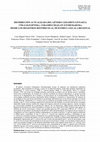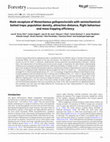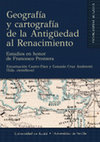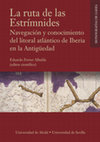Papers by Francisco J. González Ponce

Graellsia
El género Cerambyx (Coleoptera: Cerambycidae) incluye 13 especies con distribución paleártica occ... more El género Cerambyx (Coleoptera: Cerambycidae) incluye 13 especies con distribución paleártica occidental, siete presentes en Europa y cuatro en la Península Ibérica, todas ellas también registradas en Extremadura: C. cerdo Linnaeus, 1758, C. welensii (Küster, 1845), C. miles Bonelli, 1812 y C. scopolii Fuessly, 1775. Las larvas son xilófagas primarias, perforando la madera viva de árboles sanos o decaídos. Como otros cerambícidos, se incluyen en el diverso ensamble de insectos saproxílicos, un grupo funcional esencial en la degradación de la madera y la potenciación de la biodiversidad. También se han descrito como plagas, pudiendo provocar importantes daños fisiológicos, mecánicos y estructurales. El impacto de los xilófagos en las quercíneas extremeñas ha aumentado alarmantemente en las últimas décadas. Los daños se han atribuido usualmente a C. welensii, pero la evidencia acumulada muestra que este statu quo no es realista, y que C. cerdo contribuye igualmente al decaimiento del ...

Forestry: An International Journal of Forest Research, 2014
The pine sawyer Monochamus galloprovincialis is considered the most efficient vector in Europe of... more The pine sawyer Monochamus galloprovincialis is considered the most efficient vector in Europe of the pine wood nematode (PWN), the causal agent of the pine wilt disease. The detection of PWN in Europe generated great concern by the EU which, in response, implemented strong quarantine and phytosanitary measures. Among them, the improvement of monitoring and control of pine sawyer is imperative, for which better understanding of behavioural, ecological and operational factors affecting catchability is needed. In 2012-2013, we investigated with mark-recapture methods the population density, trap attraction distance, flight behaviour and mass trapping efficiency in M. galloprovincialis. Population density ranged from 96 to 474 adults ha 21. Trap attraction distance averaged 50 m. Lifetime adult dispersal was 107-122 m on average. A logarithmic diffusion model fitted to recapture data yielded a maximum dispersal of 464 m (95 per cent confidence limits: 121-2365 m). Sawyer flights were significantly more frequent downslope in the plot. Catch concentration (i.e. the ratio between the radius r of the effective trapping area S and the maximum dispersal distance r m) ranged from 0.32 to 0.41 depending on sex. Mass trapping efficiency (i.e. the ratio of the total number of adults caught in the plot (excluding recaptures) over the estimated population size) was consistently low (0.08-0.36). We conclude from an applied perspective that available lures and traps are highly effective for monitoring, but their implementation in mass trapping requires substantial improving.
El hecho de que Estrabón considere las Pitiusas más alejadas de la costa que las Gimnesias result... more El hecho de que Estrabón considere las Pitiusas más alejadas de la costa que las Gimnesias resulta comprensible si en lugar de enfocar la cuestión desde la percepción pluridimensional actual del espacio lo hacemos desde la concepción hodológica y unidimensional que compartían los geógrafos antiguos. Resulta en este caso que Estrabón describe la situación de las islas en relación con un único punto costero: Tarraco, desde donde su afirmación cobra pleno sentido. Como justificación se aporta una serie de paralelismos dentros de la propia obra estrabónica.
Habis, 1992
Resumen: Los resultados de un estudio comparativo del corpus periplográfico atendiendo las caract... more Resumen: Los resultados de un estudio comparativo del corpus periplográfico atendiendo las características originarias pueden ser interpretados como argumento para ratificar desde el plano filológico otras interpretaciones, como es el caso de la fecha de ...

ESTUDIO CLÁSICOS 160, pp. 15-32., 2021
(ESPAÑOL) El objetivo de esta contribución es ofrecer al lector no excesivamente versado en la ge... more (ESPAÑOL) El objetivo de esta contribución es ofrecer al lector no excesivamente versado en la geografı2a histórica griega una puesta al dı2a de carácter general sobre los estudios relacionados con dicha materia que han aparecido en las tres últimas décadas. La información se divide en las seis secciones siguientes: manuales de geografı2a histórica, revistas especializadas, principales proyectos editoriales y de investigación, colecciones de monografı2as, otras herramientas de estudio y algunas publicaciones recientes de interés.
(ENGLISH) 4e aim of this paper is to provide the reader who is not well versed in Greek historical geography with a general update on the studies about this subject, published in the last three decades. 4e information is organised into the following and research projects, collections of monographs, other study resources, and some recent publications of interest.
six sections: handbooks of historical geography, specialised journals, main publishing
In spite of the fragmentary condition of many of authors which wrote on that subject, we can affi... more In spite of the fragmentary condition of many of authors which wrote on that subject, we can affirm that the interest of the periplographic genre on the Straits of Gibraltar was very significant (73 references to it are detected throughout all their history). Nevertheless, this geographical accidence is mainly understood like a boun- dary between the Mediterranean and the Ocean. Only very few times is given a description of it as a geographical object, and in this case, it can be seen that our authors reveal the same lack of real know ledge as the other sources. It is a deficit that, in our case, does not seem to be corrected even once the Roman conquest of the West remarkably enriched the data on this country.

Geografía y cartografía de la Antigüedad al Renacimiento, 2020
En los escolios a Apolonio de Rodas se detectan citas de 13 periplos griegos, todos anteriores a ... more En los escolios a Apolonio de Rodas se detectan citas de 13 periplos griegos, todos anteriores a la época imperial, la mayoría de los cuales se centra en la descripción del Ponto Euxino y su entorno geográfico. Llama la atención que un buen número de ellos, muchos conservados solo por las citas de los escoliastas, son ajenos a los intereses de Marciano de Heraclea, de tal manera que la información sobre los mismos debe haber llegado a nuestros comentaristas por otras vías, más recónditas. Aparte de tales conclusiones resulta interesante analizar esta realidad en comparación con los dos “proyectos editoriales” de los geógrafos menores que nos han llegado: el corpus de París (Marciano), del que los escoliastas se sirvieron, y el de Heidelberg (¿Arriano?), en el cual pudieron haber influido los estratos más antiguos de nuestros actuales escolios.
Tra geografia e storiografia, 2020
El presente estudio pretende establecer una comparación entre la catalogación del género periplog... more El presente estudio pretende establecer una comparación entre la catalogación del género periplográfico griego que actualmente podemos establecer (género del cual conocemos datos suficientes para fijar su elenco total, con criterios de máximos, en 37 obras) y la visión del mismo que se tuvo en la antigüedad, en concreto la que se debe a nuestro más antiguo predecesor en época tardía (ca. 400): el catalogador Marciano de Heraclea. Un análisis exhaustivo de los datos permite valorar las discrepancias de ambos elencos y nos invita a intentar justificar, en la medida de lo posible, las razones que pueden haber llevado a Marciano al establecimiento de un resultado tan diverso, más fácil de entender si se saben interpretar con rigor sus verdaderos criterios selectivos, acordes con las claves de la época en que le tocó vivir.
Geographia Antiqua 28, 2019
The opuscule that has come to us with the title Γεωγραφίας ποτύπωσις, under the authorship of a c... more The opuscule that has come to us with the title Γεωγραφίας ποτύπωσις, under the authorship of a certain Agathemerus, son of Orthon, is a curious piece of writing for us, of which we know almost nothing with certainty: it was most probably a summary of a text of basic Greography intented for a reduced circle of scholars. Its content could make us consider its origin being the handling of a real or a memorized geographical chart. However, this article aims to illustrate how not even this type of geographical works, far from having any practical use, is free, ultimately, of the common accumulationof anonymous information of nautical origin that gave ancient man the only solvent tool for the intellectual conception of space, always described in one-dimensional and hodological key.

E. Ferrer Albaldea (ed.), La ruta de las Estrímnides. Navegación y conocimiento del litoral atlántico de Iberia en la Antigüedad (Monografías de GAHIA 4) (Alcalá de Henares–Sevilla 2019), pp. 185-204. ISBN: 978-84-16978-56-4 / 978-84-472-1967-4, 2019
The few remains of the supposed Periplus attributed to Carthaginian Himilco, have reached us alm... more The few remains of the supposed Periplus attributed to Carthaginian Himilco, have reached us almost exclusively through the Latin poet Avienus, who offers a triple quotation of its content in his geographical poem Ora maritima. All these remains inform us about a very complex oceanic navigation presumably destined for the Nordic and enigmatic tin islands. The enormous difficulties offered by these waters, infested with monsters and abundant in other very adverse natural features for navigation, are insisted on. From the traditional point of view, the data have been taken for good and real, and have been interpreted as proof that Himilco engaged in a tiring journey, perhaps to that area of the Atlantic known as the “Sargasso Sea”. A review of these data from the point of view of their contextualization in Greco-Latin literature can demonstrate that, regardless the degree of veracity that legitimizes it, this information responds, above all, to the defining characteristics of a literary topic on ecumenical extremes, widely used in the Greco-Latin context. Such an interpretation can even justify with more solvent reasons postulates that have always been accepted by the supporters of the traditional explanation.
I pagamenti possono essere effettuati tramite versamento a favore di TORED srl -Banca Carim Spa -... more I pagamenti possono essere effettuati tramite versamento a favore di TORED srl -Banca Carim Spa -Filiale di Tivoli 106 IBAN IT 26 U 06285 39455 CC1060075493 oppure online tramite carta di credito Le Edizioni Tored s.r.l. garantiscono agli abbonati la massima riservatezza dei dati forniti e la facoltà di chiederne la rettifica o la cancellazione. Tali informazioni non saranno in alcuna forma comunicate a soggetti terzi e verranno utilizzate solo a fini gestionali e per segnalare agli abbonati eventuali nuove pubblicazioni della casa editrice Sono vietati la riproduzione, la traduzione e l'adattamento, anche parziali, per qualsiasi uso e con qualsiasi mezzo effettuati, senza la preventiva autorizzazione scritta delle Edizioni TORED s.r.l. Ogni abuso sarà perseguito secondo la legge.
Sono vietati la riproduzione, la traduzione e l'adattamento, anche parziali, per qualsiasi uso e ... more Sono vietati la riproduzione, la traduzione e l'adattamento, anche parziali, per qualsiasi uso e con qualsiasi mezzo effettuati, senza la preventiva autorizzazione scritta delle Edizioni TORED s.r.l. Ogni abuso sarà perseguito secondo la legge.
F. Roldán Castro (ed.), El mundo árabe como inspiración (Sevilla [Secretariado de Publicaciones de la Universidad de Sevilla]-Huelva [Servicio de Publicaciones de la Universidad de Huelva] 2012) 37-66, 2012

RESUMEN: Tradicionalmente se admite que la primera parte del Periplo (pars. 1-8) refleja con mayo... more RESUMEN: Tradicionalmente se admite que la primera parte del Periplo (pars. 1-8) refleja con mayor claridad la deuda con respecto al documento original púnico que sirve de base a la obra. Dicha hipótesis, sin embargo, admite varias objeciones (debate sobre el trayecto re corrido, desacuerdo en la identificación de los lugares, rastreo induda-ble de una amplia deu da literaria, etc.). Un estudio de la toponimia citada en el pasaje en cuestión parece arro jar luz en este sentido. ABSTRACT: It is traditionally accepted that the first part of the Periplus (pars. 1-8) reflects qui te clearly a strong debt to a Punic original document that is the basis for the whole work. This hypothesis, however, is subject to a series of objections (about the distance the fleet co vers, about the identification of the sites and about the originali ty of the work, since it belongs to an evidently long literary tradition). A study of the place na mes cited in the passage should shed some light on this matter.
J. C. Posada Simeón y E. Peñalver Gómez (eds.), Cartografía histórica en la Biblioteca de la Universidad de Sevilla (Sevilla [Secretariado de Publicaciones de la Universidad de Sevilla] 2010) 10-30 , 2010
M. Albaladejo Vivero (ed.), Viajes y relaciones interculturales en la Antigüedad (Guadarrama [Ayuntamiento de Guadarrama] 2010 [ISBN: 978-84-614-6299-5]) 87-99, 2010






Uploads
Papers by Francisco J. González Ponce
(ENGLISH) 4e aim of this paper is to provide the reader who is not well versed in Greek historical geography with a general update on the studies about this subject, published in the last three decades. 4e information is organised into the following and research projects, collections of monographs, other study resources, and some recent publications of interest.
six sections: handbooks of historical geography, specialised journals, main publishing
(ENGLISH) 4e aim of this paper is to provide the reader who is not well versed in Greek historical geography with a general update on the studies about this subject, published in the last three decades. 4e information is organised into the following and research projects, collections of monographs, other study resources, and some recent publications of interest.
six sections: handbooks of historical geography, specialised journals, main publishing